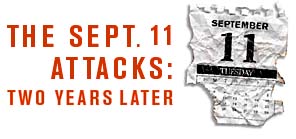
State, feds
had no plan for
attacks in Hawaii
Two years ago today, then-Gov. Ben Cayetano was forced to confront a new fear.
Cayetano said he was shocked to learn that "the state and, later I found, even the federal government had developed contingency plans for all types of crises -- except for a terrorist attack in Hawaii."
He ordered the state's National Guard to secure the airports with armed, uniformed Guardsmen.
The most difficult moment came after learning that Hawaii Air National Guard fighter pilots were activated by the federal government and had orders to shoot down any commercial airliner or private plane that did not obey orders to land at designated airfields.
Hawaii, Cayetano said Tuesday, has two armed F-16s aloft at all times.
With more than a dozen commercial airliners heading for Hawaii or the mainland now being diverted, some of the planes would have to land either on Maui or the Big Island.
"I was told some of the commercial airline pilots, unaware of the WTC (World Trade Center) attacks, had expressed concerns about landing their 747s at Kahului or Kona," Cayetano said.
"The thought of a foreign pilot disobeying the order and getting shot down was unsettling, to say the least," Cayetano recalled.
"I spoke to the general in charge and asked who would give the orders to shoot down the airliners. He told me a lieutenant colonel was monitoring all of the incoming aircraft and would make the decision. I could hardly believe it, but it seemed to be an example of how the attacks had taken even our military by surprise," Cayetano said.
Since then the orders have been refined and would now come from the president of the United States, according to the National Guard.
The city may actually have been more prepared. Mayor Jeremy Harris noted that the city has had plans since 1997 for a biological terror attack.
The terrorist attacks two years ago served as "a cold-water slap in the face" for Americans, Harris said, but some planning had already been done.
"I don't think we placed it with a high probability of occurring, but we had plans on how to deal with up to 100,000 fatalities in the first four days of a biological attack," Harris said.
Since 9/11, Honolulu has set up a system to monitor all large public gatherings such as football games or Waikiki Shell concerts to sample the air for possible biological contamination with anthrax or other airborne diseases.
If something is detected, the city is able to send a mobile DNA-testing van to the site to confirm the organism, and if it is dangerous, the city can trigger a system to vaccinate people before they leave, Harris said.
The city has also put in place a system to continually monitor the air at six different sites around the island and in Waikiki to test for airborne biological contamination.
"I don't know of any other city that has done this much," Harris said.
"I think the public perception is that we are not as much at risk," he said. "The reality is, we are not a top-priority target, but we are certainly above most of the United States. Waikiki and Pearl Harbor are internationally known symbolic targets and have a higher target status than many places."
Richard Pratt, director of the University of Hawaii public administration program, said because Hawaii is geographically isolated and more concerned with Pacific and Asian events, the attacks in New York and Washington seem more distant.
"The impact is simply less here," said Pratt, author of "Hawaii Politics and Government."
